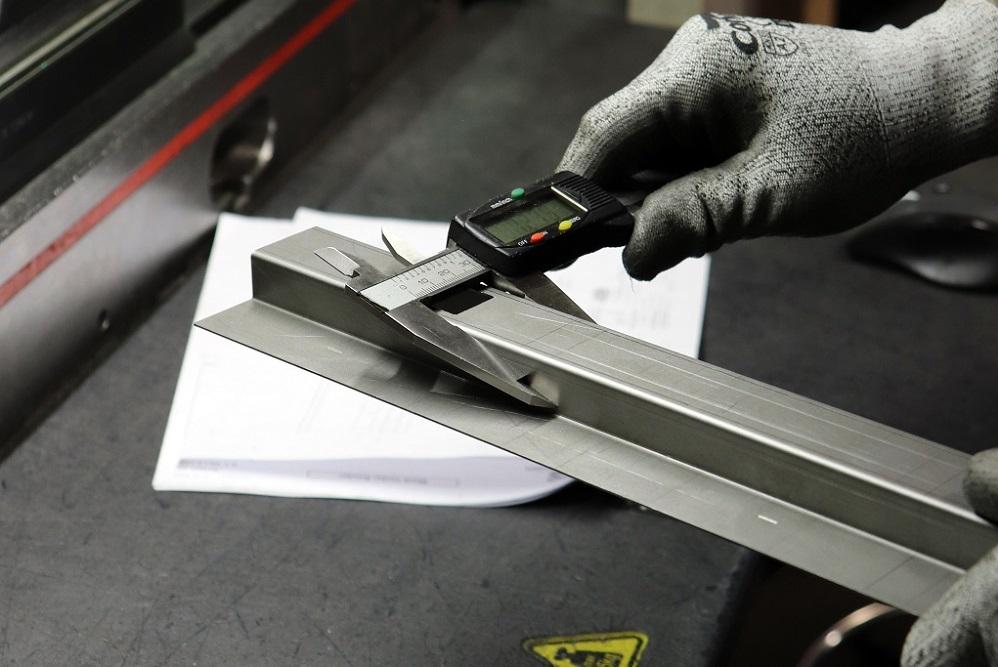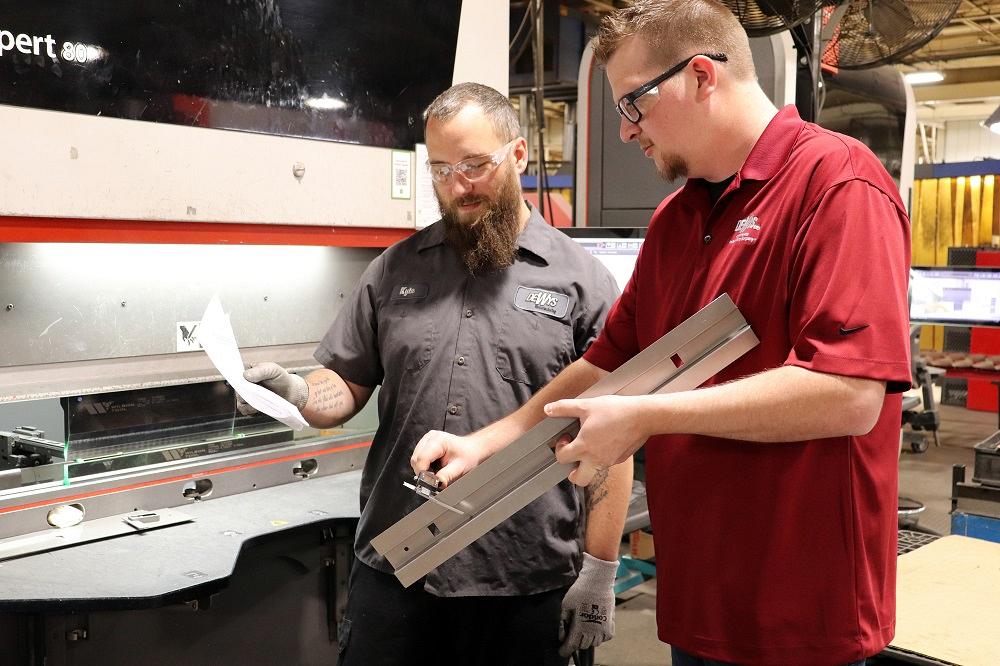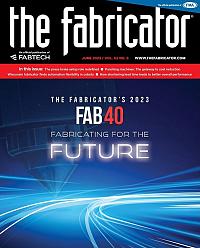Editor-in-Chief
- FMA
- The Fabricator
- FABTECH
- Canadian Metalworking
Categories
- Additive Manufacturing
- Aluminum Welding
- Arc Welding
- Assembly and Joining
- Automation and Robotics
- Bending and Forming
- Consumables
- Cutting and Weld Prep
- Electric Vehicles
- En Español
- Finishing
- Hydroforming
- Laser Cutting
- Laser Welding
- Machining
- Manufacturing Software
- Materials Handling
- Metals/Materials
- Oxyfuel Cutting
- Plasma Cutting
- Power Tools
- Punching and Other Holemaking
- Roll Forming
- Safety
- Sawing
- Shearing
- Shop Management
- Testing and Measuring
- Tube and Pipe Fabrication
- Tube and Pipe Production
- Waterjet Cutting
Industry Directory
Webcasts
Podcasts
FAB 40
Advertise
Subscribe
Account Login
Search
How the press brake setup person’s role has evolved in the fabrication shop
Modern metal fabricating technology has resulted in a major role change in the bending department
- By Dan Davis
- June 23, 2023
- Article
- Bending and Forming

The role of press brake setup operator doesn’t exist as it once did at DeWys Metal Solutions, Marne, Mich., but that doesn’t mean the responsibilities of the role went away. Responsibility for quality checks, for example, now reside with the brake operators. Images: DeWys Metal Solutions
Metal fabricating technology has changed greatly over the years, so it makes sense that shop floor roles change as well.
One example is the role of the press brake setup specialist. For most shops, this experienced person helped to squeeze as much productivity as possible out of the bending department. He determined the forming method (air forming or bottom bending), calculated the inside bend radius and appropriate die opening, located and installed the correct tooling, figured out the bend sequence, tried out some test pieces, and measured to see if the results matched the job specs. Despite the many steps, an experienced hand could get the brake set up in 15 to 20 minutes, if most of the steps went smoothly.
Well, some of those forming experts remain in the workforce, but they aren’t as plentiful as they once were. Manufacturers and job shops can verify that, as they are lucky to find anyone interested in running a press brake nowadays, much less an experienced press brake operator looking to learn new machines and processes.
Forming technology has improved to the point where companies still can be productive even with less-experienced brake operators. Advanced controls and precision-ground tooling have made the brake a lot easier to not only run, but also setup and prove out a bending program.
In a way, the press brake setup person still exists, but the role is not limited to one or two bending gurus. Today, press brake operators take on many of these duties. Such is the case at DeWys Metal Solutions in Marne, Mich.
Forming a New Approach
DeWys took an aggressive step forward on its manufacturing modernization journey more than a decade ago when it purchased six 150-ton Bystronic Xpert hydraulic press brakes. These devices now make up the heart of the company’s bending department.
The decision was made in the spirit of standardization. With a majority of the press bakes having the same software and capabilities, training could be streamlined, and inexperienced operators could get to the point where they were making parts more quickly than if they had to use older technology or get used to different brakes with different control interfaces.
“It’s more than twice the length of time to get somebody to understand how to run some of our old equipment compared to learning how to run our Bystronics,” Laura Preuss, DeWys’ director of workforce development. “We no longer have to spend time interviewing people, looking for skill sets that you really can’t find. We can take someone with a totally different background, train them, and have them excel in the press brake area.”
DeWys has about 20 to 25 press brake operators at any time working over three shifts. (The number fluctuates as press brake operators also might be working in other areas of the facility.) Preuss added that they are always looking for more to add to the ranks.
The bending department is up to nine press brakes. Some automation has been added over the years. The company has an automated Bystronic Xpert 40-ton press brake cell and an older 60-ton Cincinnati brake paired with a cobot. The latter is making use of something that’s not as vital as it once was when the more modern press brakes arrived.

After the press brake operator double-checks the bend dimensions and compares them to the job specs, he consults with a lead in the bending department to get first-piece sign off.
“We’re taking an older piece of equipment that we don’t really train anybody to use anymore, and now it’s become a great second-shift employee,” Preuss said.
Despite the success with automation and advances in press brake automation, humans still remain an important ingredient when it comes to keeping up with blanks flying off the fiber laser cutting machines. Even if they might not have the depth of knowledge as that of an old-school press brake setup specialist, they are performing at a high level at DeWys. This is how they are doing it.
Offline Programming Addresses the Prebend Calculations
DeWys has moved to offline programming for most of its metal fabricating equipment, press brakes included. In doing so, even less-experienced operators can get to making parts as soon as possible, rather than spending time trying to determine how to meet the job specs.
The software addresses prebend calculations that used to be the responsibility of press brake setup specialist. The software not only calculates the inside bend radius, but also checks the tooling inventory to see if the right punch and die are available.
The software also addresses safety aspects related to the job. It takes into account the thickness and type of material being bent, then assesses the forming tonnage needed for the job and compares that to the press brake load limit and tooling load limit.
In the end, the correct tooling and bending sequence is matched to the job. A flat pattern is developed and connected to both the digital and print versions of the traveler.
This is also the point where the press brake operator takes over from the offline programmer.
“Our offline programmer does a fantastic job, but everybody makes mistakes,” said Kris Cousineau, DeWys’ press brake trainer. “Because of that, we have put into our training program to look at the print and the controller to make sure the bends are going the right way, for example.”
Operators Don’t Go Hunting for Tooling
When the company installed the new press brakes in the DeWys facility, they also installed a tooling cart next to each brake. In each of those carts was a standardized set of precision-ground tooling.
The goal was to keep brake operators from going on a walkabout of the shop floor, looking for that punch or die that someone else used for another job on another brake but failed to return to the tool crib. Sometimes what might normally be a five-minute job to retrieve tooling could turn into an hour-long search. Today, that’s no longer the case.

Each of the Bystronic press brakes at DeWys have similar tooling organized in similar racks. The goal is to prevent press brake operators from wasting time as they walk around looking for missing tooling.
“This has definitely helped us to cut down on our setups and lean out our processes,” Cousineau said.
Of course, not all tooling can be duplicated for every brake. Some radius tooling, smash dies, or customer-supplied tooling, for example, might be located elsewhere and require a walk to retrieve. But for the most part, operators don’t have to leave their stations. They can take a look at the controller, see where the tooling is supposed to go, and lock it into place.
Operators Review the Job
As part of the DeWys training, brake operators are asked to look at the print that comes with the traveler for the job and compare that to the job steps on the controller. The operator not only needs to check to see that the bends are going the right way to deliver the final form, but also that the blank is presented to the backgauge in the correct direction, ensuring the bend is symmetrical and not bent backwards.
The operator then proceeds on the path to get first-piece sign off. After the bending sequence is complete, the operator measures the bend dimensions to see if they meet the job specs. (Just as each brake has a set of standardized tooling nearby, each station also has its own set of calipers and protractors.) When tweaks are needed, which is most of the time, according to Derek Lemmen, a DeWys training instructor, the operator can make a note in the control software so the job instructions can be updated.
“If you ever get a part and there are no problems or corrections, you’re always very suspicious as to why that might have happened because that’s very unusual,” Lemmen added.
Once the job has been tweaked and the operator has confirmed the bending plan, he needs to find a qualified operator to sign off on the first qualified piece. Lemmen said an experienced operator can confidently work through this process and get that first-piece sign off in as few as five minutes. An inexperienced operator might take a bit longer until they have familiarity with the brake and the setup process.
Who Are the New Generation of Brake Operators?
With the change in press brake roles, the new generation of press brake operators at DeWys is changing as well. Today’s operators aren’t likely to have formal metalworking training. Lemmen said that it’s more of a search nowadays for people who are “mechanically inclined.” They might not be able to walk right up to a press brake and get to work, but they won’t need a lot of time to figure out how things are done.
One of the tools that gets DeWys closer to finding out who these potential press brake operators are is a mechanical reasoning test that they give to job applicants. Preuss said that if someone scores well on the test, they likely will be sufficient in front of the brake.
“The other thing that we look for is if somebody is expressing interest [in working with press brakes],” Preuss said. “Do they seem interested in wanting to learn? Are they motivated?
“The training is easy if you have somebody who has the drive to want to do it,” she added.

DeWys made a decision to standardize on one type of hydraulic press brake about a decade ago because they were user-friendly and the learning curve for new operators was shorter than with traditional brakes. Older press brakes, as a result, weren’t used as much. At least that was the case until a collaborative robot was paired with one of the older brakes.
Lemmen mentioned that as some of the press brake operators get accustomed to the brake controls and handling workpieces, they become more interested in the science behind the bending. “They’re curious about how you to do it without the aid of a computer,” he said.
As long as Cousineau and Lemmen are around, press brake operators at DeWys have the chance to pick the brain of trainers who have knowledge of how jobs were set up on older press brakes. There are always parts to get out, but the company also affords opportunities for its employees to become more knowledgeable about their jobs.
The training never stops, especially when technology keeps moving forward. DeWys is actually supposed to be installing two new press brakes with automatic tool changing systems in the coming weeks. Press brake setup is evolving once again.
About the Author

Dan Davis
2135 Point Blvd.
Elgin, IL 60123
815-227-8281
Dan Davis is editor-in-chief of The Fabricator, the industry's most widely circulated metal fabricating magazine, and its sister publications, The Tube & Pipe Journal and The Welder. He has been with the publications since April 2002.
Related Companies
subscribe now

The Fabricator is North America's leading magazine for the metal forming and fabricating industry. The magazine delivers the news, technical articles, and case histories that enable fabricators to do their jobs more efficiently. The Fabricator has served the industry since 1970.
start your free subscription- Stay connected from anywhere

Easily access valuable industry resources now with full access to the digital edition of The Fabricator.

Easily access valuable industry resources now with full access to the digital edition of The Welder.

Easily access valuable industry resources now with full access to the digital edition of The Tube and Pipe Journal.
- Podcasting
- Podcast:
- The Fabricator Podcast
- Published:
- 04/16/2024
- Running Time:
- 63:29
In this episode of The Fabricator Podcast, Caleb Chamberlain, co-founder and CEO of OSH Cut, discusses his company’s...
- Trending Articles
Tips for creating sheet metal tubes with perforations

JM Steel triples capacity for solar energy projects at Pennsylvania facility

Are two heads better than one in fiber laser cutting?

Supporting the metal fabricating industry through FMA

Omco Solar opens second Alabama manufacturing facility

- Industry Events
16th Annual Safety Conference
- April 30 - May 1, 2024
- Elgin,
Pipe and Tube Conference
- May 21 - 22, 2024
- Omaha, NE
World-Class Roll Forming Workshop
- June 5 - 6, 2024
- Louisville, KY
Advanced Laser Application Workshop
- June 25 - 27, 2024
- Novi, MI


























